 |
EDITORIAL
Apis-UK
Christmas and a new year are rapidly
approaching as I write and for many beekeepers it is a time to
reflect on their beekeeping
year and take stock of things as they stand. For me, it has been
a most interesting year both with my bees and with Apis-UK which
is growing steadily and surely and gathering a worldwide readership.
This success is of course due in no small measure to those who
contribute and to all of you who have written in to ask questions
or praise or complain or with articles, or poems, I offer you my
sincere thanks. To those who have thought of writing about their
experiences with bees, please don’t hesitate. We welcome
your input.
Honey Shows
This year I was privileged to be asked to talk at the French Bee
Breeders/Queen rearers Association meeting in Lomoges (a short
report is written below) where I met with a group of dedicated,
dynamic, knowledgeable bee people who I am sure impressed me more
than I impressed them. From there I was able then to continue on
to the London Honey Show, that show piece of British apiculture.
Whenever I visit one of these top shows, I am always astounded
at the excellence of the entries to the competitions. The colours
and clarity of the various honeys and meads, the perfect translucence
of the wax exhibits and the general overall standard of the entries.
I know well the effort that goes into preparing for such an event,
having entered my local beekeeping association show in my first
year of beekeeping. In that particular show, another beekeeper
had entered a jar of honey with bits of bee in it to see if anyone
noticed. The judge did notice, became annoyed that someone was
not treating the affair with the respect he felt it deserved and
rechecked all the entries. He then noticed that my winning entry
was a micro nanometre below the line and disqualified it. I then
inadvertently drank most of a bottle of someone’s prize winning
mead which I thought was part of the spread, and have to draw a
veil over the rest of the proceedings lest I embarrass myself.
I still go red at the thought of it all. Suffice to say, my show ‘career’ was
nipped in the bud, but my respect for those who enter these competitions
rose enormously. I mean it. But even the great and famous will
resort to certain questionable tactics in order to win at honey
shows. I read once that Lord Baden Powell of scouting fame heated
his honey before a show and accidentally left it in the oven for
several hours. When he retrieved it, the honey had turned a very
dark brown/black colour. He entered it in the relevant class and
won; re-entering it for several years in a row, again winning each
year. Such are honey shows. Interesting, challenging, hard work
for entrants and judges, and in the case of the London show, very
well presented. The talks were relevant and interesting, but for
the rest of the show, which consisted essentially of trade stands,
I found it to be smaller than before, with many well known names
on the absent list. Let us hope that the move in 2004 to the Royal
Air Force Museum in more accessible Hendon will tempt them back.
I will certainly be there, and no, not as one of the museum exhibits.
I always learn a lot at these shows particularly by talking to
manufacturers and scientists and of particular interest to me were
the advances in research on combating varroa and other bee diseases.
A small survey on this is discussed below in the article section.
Different countries appear to be taking slightly different approaches,
but all aimed at the same target.
Another Day in Paradise
Christmas time often brings to the minds of many, their favourite
charities and our various endeavours to assist those less fortunate
than ourselves. There are several beekeeping charities in the UK,
mainly working abroad that do brilliant work often under difficult
circumstances. Do think of them this year and next, and do try
to assist in whatever way you can. In many of these underdeveloped
countries, a little can make a huge difference to peoples’ lives
and we as beekeepers can and should help as much as we can. In
this issue of Apis-UK, we introduce you to ‘The Honeypot
Charity' a charity working solely in the UK to assist severely
disadvantaged kids, for whom Christmas is just yet another awful
day. They attended the honey show in an effort to gain assistance
and support from the beekeeping community, and are very worthy
of our attention. ‘Another day in Paradise’ the hit
song by Phil Collins effectively sums it all up and describes the
position of most of us, so please think about it, and if you can
help, please do.
Another better known charity, IBRA is also featured in this issue
(in the news), with the launch of its new promotion, ‘Buzz
Extra’ and its plan to attract ‘Friends of IBRA’.
IBRA is a charity that directly and indirectly affects all of us
as beekeepers and without it our beekeeping would be immeasurably
poorer. It deserves our support.
GMOs
GMOs ‘crop’ up in this issue again, (in the news),
and I think that like it or not they will be a constant source
of news and comment for the foreseeable future. Your views on this
science are always welcome whether in support or against. And if
you do comment, please let me publish your comments. Don’t
be afraid of criticism. I get it all the time and believe me, it
grows on you.
Apimondia 2005
So ends one Apimondia and so begins the publicity for the next.
It looks as though our Irish friends together with support from
all of the Islands home countries are preparing for quite an extravaganza.
I look forward to it being my first Apimondia despite having been
a beekeeper for some years now, and hope to see many friends in
Dublin in 2005. (And taste Guinness at source of course). Information
on the 2005 Apimondia in Dublin is shown below. (See In the News).
This Issue
This December 2003 issue includes the usual mix of news items,
articles and other items of interest including an extremely tasty
recipe, some scintillating advice on what to do about constipation
and we even introduce you to a link between plate tectonics and
honey. As a former geologist and now a beekeeper, (with a few things
happening in between) I found this especially interesting. I am
also happy to declare that the long standing mystery of the hollow
bumblebees may now (I think) have been solved. I never give up
on these things and the information we present is at least a possible
answer to this long standing question. It’s all to do with
flies of course, and if anyone knows better, let us know. (See
below).
The Year ahead
So Apis-UK will now forge ahead into the new year and I hope that
with your support we can continue to grow, both as an online magazine
of real interest to beekeepers, and as a forum for new ideas, -
and your ideas. Beekeeping is a fast moving, dynamic and absorbing
occupation for professionals and hobbyists alike and I would like
this magazine to reflect that.
In the meantime, I wish everyone a very happy Christmas and a prosperous
new year.
David Cramp. Editor.
NEWS
BEEKEEPERS NEWS CEASES PUBLICATION
The well known Beekeepers News published by EH Thorne
(Beehives) Ltd was published for the last time with production
of the September
issue. This publication issued free to subscribers for the cost of
postage has been produced by Thornes for 25 years and over this time
has provided an enormous amount of advice, humour, criticism and
reasoned arguments on just about every topic associated with beekeeping.
During this time, the editor, Paul Smith has advised, cajoled and
blasted away at various government ministers left, right and centre
and has pulled no punches when discussing the failings of officialdom
in whatever country. (He even criticised Spanish beekeepers once,
but everyone makes mistakes!). So with issue 100, we say
goodbye to an excellent publication which I expect must have been
required
reading for aspiring leaders of the opposition and which I really
know will be missed by thousands of beekeepers, including myself.
Ed.
SPAIN BANS BEE IMPORTS FROM COUNTRIES WITH THE SMALL HIVE BEETLE
In concert with many European nations, the EUs biggest producer of
honey, Spain has now banned imports of bees, queens, hives and
biological apicultural materials from countries with the small
hive beetle, and extends to those with Tropilaelaps clarae. Spain
produces around 36,612 tons of honey (2002 figures) from 2.4 million
hives worked by more than 27000 beekeepers. Representatives of
one of the most productive regions of Spain (around Guadalajara)
have welcomed the ban and have said that there is no danger of
contamination (with the beetle). No danger? Sounds a bit
like varroa. Ed.
CAN HONEY BEES TELL WHICH HONEY IS WHICH?
Learning and discrimination of honey odours by the honey bee
In an interesting piece of research
by French scientists, (Isabelle Bonod, Jean-Christophe Sandoz, Yves
Loublier and Minh-Hà Pham-delègue),
the research team used classical conditioning of the proboscis extension
response to test whether the natural discrimination ability of honey
bees could be used to assess the origin of honeys. Five honeys were
used as the conditioning stimuli in the procedure: linden (Tilia
spp.), oilseed rape (Brassica napus), eucalyptus, sunflower (Helianthus
annuus), and black locust (Robinia pseudoacacia). Bees exhibited
high levels of conditioned responses to all honey odours. Responses
to the conditioned honey were usually the highest, but high levels
of generalisation; i.e. behavioural response to other honeys, were
recorded. Using a differential conditioning procedure where one honey
odour was rewarded and another odour was explicitly unrewarded, we
showed that honey bees could not always differentiate between honey
types. For the full report, in which the potential use of the honey
bee as a biological detector to discriminate among honeys is discussed,
see Apidologie 34 (2003) 147 - 159.
HONEY CAN SHOW US HOW THE WORLD WORKS
A French scientist has found a link between plate tectonics, honey,
pancake batter and toothpaste and his theory could be useful for
honey packers in determining how quickly they can fill containers
of honey and indeed other viscous fluids. In a paper published in
the Physical Review E, 68, 2003, Neil Ribe of the Institute of Global
Physics found that poured cake mix forms a thin sheet and folds over
when it hits the bowl because of its density to viscosity ration.
Ribes found that light or highly viscous fluids such as toothpaste
must be extruded through a slot in order to flow and their rate of
extrusion controls their folding. Honey and syrup on the other hand,
being denser and runnier, and gravity pulling the fluid down is the
main factor. Calling these two affects ‘forced’ or ‘free’ folding,
he finds he can predict what will happen under different conditions
and how often in each case a sheet will double over. His theory also
sheds light on the movement of molten rock deep within the earth.
The tectonic plates buckle when they sink and encounter obstacles
such as thicker or denser rock. (Although these plates seem rigid,
they do flow over geological time i.e. over millions of years).
FRENCH HONEY BEE PROBLEMS
In an interesting report by the BBC, it seems that the heat wave
that affected most of Europe this Summer has brought with it great
problems to many of France’s 80000 beekeepers. One beekeeper
taking his 400 hives to the lavender and other wild flowers of
Provence said that due to the heat drying up the flowers, only
40 made any honey and he only just about covered the cost of transporting
them there. Honey production in the country is down by over 50%
nationally from the 1.3 million hives in France.
Evidently, winter losses have also increased from around 1 beehive
in 10 to about 6 in 10, with opinions as to the cause much debated.
The French National Bee Surveillance Unit believes that the massive
use of pesticides is weakening colonies and because of this they
are becoming more vulnerable to infections, but other beekeepers
blame the use of imported bees and subsequent crosses upsetting the
natural balance.
Flowers are what bees are all about, and this piece of news uncovers
some interesting facts about pollination, fertilisation and scent.
SCENT PRODUCTION AND POLLINATION IN PLANTS
Scientists from Purdue University in the USA, have discovered the
processes responsible for shutting down scent production in certain
flowers once they have been pollinated. Studying petunias and snapdragons,
they found that in petunias, the plant hormone ethylene, produced
after pollination, suppresses activity of the gene that triggers
the creation of BSMT (an enzyme that produces a reaction that produces
the substance providing the scent). Without this, the flower cannot
produce scent. What they also found was that it is often fertilisation,
not just pollination that sends the signal to decrease and halt scent
production. Production of scent is an expensive process for a plant
from an energy point of view, yet plants such as snapdragons continue
to produce scent after pollination. Here, they found that it takes
some 48 hours from pollination to effective fertilisation and not
until this achieved does the snapdragon stop producing scent. This
process occurs with petunias as well but in a shorter time. This
time matches the time taken for the pollen tubes to reach the ovaries.
In other words, the time delay is an insurance policy for the plant.
If fertilisation fails, the plant will have to continue to attract
pollinators.
The full report can be found in the December issue of ‘The
Plant Cell’, or in advance on line in ‘The Plant Cell
Review’, Thursday 20 Nov.
SUGARY FOODS. CAN THEY CAUSE BIRTH DEFECTS
In a report published by the American Journal of Clinical Nutrition,
researchers from the University of California, compared the diets
of 454 mothers of children with neural tube defects like spina
bifida, and 462 mothers who had healthy babies. They discovered
that the risk of defects doubled in women who ate lots of food
which gave a quick sugar hit and amongst obese women, this risk
quadrupled. The scientists concentrated on foods that have a high
glyacemic index (GI). These foods release a large amount of glucose
into the blood quickly and foods which do this include honey, white
bread, potatoes, cooked carrots, cooked rice, chocolate biscuits,
and some soft drinks. Other scientists and experts play down the
danger stating that the science is very new and that so many other
things feed into the metabolic process that control development
and closure of the spinal column that to isolate one factor would
need a lot of corroboration and that the research should be treated
with caution until further studies back up these findings.
IBRA STARTS PUBLICATION OF BUZZ EXTRA
IBRA the Cardiff based centre of information on everything ‘bees’ has
launched its latest publication, Buzz Extra, a quarterly newsletter
to be distributed in the first weeks of February, May, August and
November. The purpose of the newsletter is two fold. Firstly to keep
members and supporters of IBRA informed and updated with interesting
snippets of news in between those times when they receive the Association’s
journals, and secondly to allow non members to take a peep into international
apiculture and get a peep at what IBRA does and can offer anyone
interested in bees. The Director Richard Jones, asks that if you
love your bees and wish more people understood their value to the
environment and the economy, then help us in our task of spreading
that educational information. He adds that for beekeeping in most
areas of the world, for most if not all types of bees, IBRA has the
data and information available to help, and he cites the typical
example of a recent visit to Kenya, where lots of well intentioned
people, full of enthusiasm and ideas were conducting projects on
different types of hives and looking at different bee forage calendars.
He found it hard to tell them that what they were doing had been
done before - several times and that all the data was available at
IBRA. By supporting this new initiative all beekeepers can contribute
to the vital task of disseminating this information to those who
need it. Any donation is welcome, but from 5 pounds sterling per
annum, you will receive a quarterly copy of Buzz Extra with its glimpse
into the wider world of beekeeping and you will help in the vital
tasks of IBRA. See www.ibra.org.uk
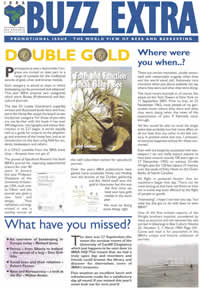 |
| IBRA. BUZZ EXTRA |
I am delighted now to introduce readers of Apis-UK to The
Honeypot Charity, members of whom I met at their stand the London
Honey
Show this year. They came seeking support from the beekeeping community
especially in the Hampshire area where they run Honeypot House
in the New Forest.
THE HONEY POT CHARITY
Honeypot is dedicated to improving the quality of life for severely
disadvantaged children living in the UK. The Honeypot relationship
with each child begins with a respite holiday at Honeypot house and
continues with a comprehensive programme of long term support within
their home environment. This latter service is achieved in a variety
of ways such as visiting the children in the honeypot bus, sending
photos of their holiday, sending birthday and Christmas cards, an
invitation to one of the Christmas parties and so on. They have extended
their philosophy to helping teenage mothers with holidays under their
teen mum’s project.
The charity holds a number of fundraising events throughout the year
including parachute jumps, singles nights, carol concerts, wine tasting
and even a golf tournament here in Andalucia at the San Roque Golf
course. So to have a good time, and have the chance of helping children,
why not take a look at www.honeypot.co.uk and find out what you can
do.
 |
| The Buzz |
APIMONDIA 2005
Many of you will by now know that the next Apimondia will be held
in 2005 in Eire in the city of Dublin. With its slogan of “Five
millenia of Beekeeping on your doorstep”, the 39th Apimondia
International Congress will take place between August 21-26th. This
Apimondia is being hosted by The Federation of Irish Beekeepers’ Associations
and is being organised in conjunction with the Ulster Beekeepers
Association, with support from the British, Scottish and Welsh Beekeepers
Associations. This means of course that beekeepers in the UK are
involved in this as well and we hope that all support necessary will
be given to our Irish Beekeeping friends. For more information on
this event, see www.apimondia2005.com
 |
ANERCEA
ASSOCIATION NATIONAL DES ELEVEURS DE REINES ET DES CENTRES D’ELEVAGES
APICOLES
I recently had the pleasure of meeting with and talking to this French
Association of Bee breeders and Queen Rearers in Limoges. Each year
they hold two two day meetings to which are invited speakers of note
who talk on relevant topics. This second meeting of the year included
talks by Gudrun Koeniger the very well know international bee scientist
from Germany who talked on Drone Congregation Area research (of especial
interest to me). This brilliant update of knowledge on the subject
will be of interest to all beekeepers interested in this very under
researched aspect of honeybee mating. John Harbo from the US Baton
Rouge ASDR Bee research establishment acquainted us with his remarkable
on going research into producing a varroa tolerant bee. And his success
is amazing so far using the heritable trait involved in the suppression
of mite reproduction. Giles Fert, author of the excellent book on
queen rearing followed up with information on the importance of drones.
My contribution included the practical details of finding and studying
DCAs and a resume of bee research in Spain. During this two day period
I found myself talking to a very dedicated group of people who keep
themselves fully up to date with advances in the world of bee keeping.
There were no moans and groans about the state of affairs in the
industry or the affliction of varroa etc, just a thirst for knowledge
and a willingness to share their knowledge with others. The group
included a remarkable number of young beekeepers too, i.e. people
under 52. All in all this was a very enjoyable experience for me.
A full report on the talks will be given in Apis-UK as soon as possible.
 |
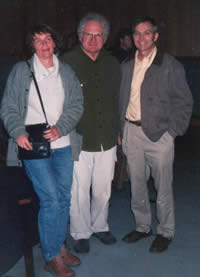 |
Gudrun Koeniger in conversation
at the french Bee Breeders meeting |
John Kefuss
an American bee breeder in France and co worker Maria Bolt,
together with John Harbo USDA (right) |
THE BRITISH BEEKEEPERS ASSOCIATION APPOINTMENT
OF GENERAL SECRETARY
The British Beekeepers Association is seeking to appoint a General Secretary.
This is position of importance and highly influential in the continuing development
of BBKA, its activities in the promotion of bees and beekeeping to the public
and in the training and development of beekeeping skills within its membership.
The person appointed will have a sound knowledge of the beekeeping and possess
excellent communication skills needed to explain BBKA policies using modern media
channels. The General Secretary is also required to liaise with relevant Government
departments and with specialist national and international organisations whose
activities impinge on bees and beekeeping. The General Secretary will report
to the Chairman of the Executive Committee and has overall responsibility for
efficient record keeping, the business affairs of the Association and the planning
and preparation of its events and meetings. It will be necessary to attend many
of these activities personally. Routine office duties and the first point of
communication with members and the public lie with the Office Administrator who
will work under the direction of the General Secretary. BBKA policies and activities
are decided by its Executive Committee of which the General Secretary is a member.
The work should occupy an average of 2 days per week with some flexibility. Salary
will be commensurate with hours and existing experience. The post could be home
based with effective communication facilities, although attendance at the National
Beekeeping Centre will be frequent. Further information may be obtained from
BBKA Chairman, Glyn Davies Tel 01364 652640 Application to be made in writing
enclosing Curriculum Vitae by January 9th 2004 to by January 9th 2004 to National
Beekeeping Centre or BBKA Chairman, Landscore, Eastern Road, Ashburton, Devon.
TQ13 7AR Download Job
Description 50KB PDF GMO DRAFT DECLARATION
The GMO debate continues and now, an MP is seeking support for a
draft declaration on the science. Joan Ruddock MP has set up a web
site on which she seeks support for the following declaration:
“ I recognise the contribution of genetic modification in the development
of pharmaceuticals and the enormous value of modern drugs to human
health.
I support continuing research but believe that GM development and
production in the living environment is radically different from
the pharmaceutical factory.
My concerns about growing genetically modified crops in the UK are:
a. inadequate research into possible human health effects.
b. proven environmental damage arising from gene transfer to non
GM crops and “stacking” of herbicide resistant genes.
c. no guarantee of consumer choice between GM and non GM foods.
d. no liability on biotech companies for any damage done by GM food
and crops.
e. no clear evidence of long term economic benefits.
Furthermore, I am not convinced that GM crops are the answer to
world hunger.
In most developing countries inadequate food supplies are the result
of distribution and storage problems. Environmental risks may be
even more profound in the rich biodiversity of those countries and
corporate control over the food chain and seeds could jeopardise
local economies.
And so, based on the facts available to me at present, I cannot support
the commercial growing of GM crops in the UK.” The website
is at: www.gmno.org.uk
Take a look and see whether you as a beekeeper
support the declaration. Let me know what you think. Ed.
Still on the subject of GMOs a recent paper in Apidologie suggests
that bee larvae can be used to assess the effect of transgenic products
on non target organisms. The full paper can be found in Apidologie
34 2003, pages 139 to 145.
ENVIRONMENTAL RISK ASSESSMENT OF TRANSGENE PRODUCTS USING
HONEY BEE (APIS MELLIFERA) LARVAE (ABSTRACT)
Henrik F. Brodsgaard, Camilla J. Brodsgaard, Henrik Hansen and Gábor
L. Lövei Department of Crop Protection, Danish Institute of
Agricultural Sciences, Research Centre Flakkebjerg.
An environmental concern regarding the cultivation of transgenic
crop plants is their effect on non-target organisms. Honey bees are
obvious non-target arthropods to be included in a risk assessment
procedure but due to their complex social behaviour, testing transgene
products on individual bees is not possible in bee colonies. We employed
a laboratory larval rearing technique to test the impacts of such
transgene products on honey bees. A serine proteinase inhibitor (Kunitz
Soybean Trypsin Inhibitor, SBTI), that is a source of insect resistance
in transgenic plants, was used as a model insecticidal protein on
honey bee larvae reared individually in the laboratory. The addition
of 1.0% SBTI (w:w of total protein) to the larval diet created significant
additional larval mortality, slowed juvenile development and significantly
decreased adult body mass. Our results suggest that the larval rearing
technique can be used to monitor direct side-effects of transgene
products on individual honey bee larvae.
POSTED ON THE BIBBA-L MAILING
LIST
Subject: Breeding for Varroa
resistance
With the likely loss of effectiveness of Bayvarol and Apistan as
easily applied treatments for varroa in the near future, our attention
should be drawn to looking for signs of natural resistance in our
bees to the mites. As a bee breeding organisation, it is important
and appropriate that we continue to take the lead in this country
in these efforts. John Dews has reported in Bee Improvement magazine
on progress made since 1997, and there is now one other substantial
group in south west England working on similar lines.
I would appeal to you to play some part, either as an individual
or as a part of a locally organised group, in furthering the quest
for bees resistant to varroa.
If you are already doing this, or would like to begin these studies,
please let me know since we are now well placed to give suitable
advice and support. Albert Knight BIBBA Groups Secretary Tel: 01773
745287
BOOK REVIEW
THE BEEKEEPERS ANNUAL 2004
The new Beekeepers Annual follows the same format as its predecessors
and for those who know it well it will hold no surprises, but of
course will update their knowledge of who is who and what is what
in beekeeping in the Islands. For those who have never met the annual,
it is especially recommended as a source of information on just about
every beekeeping organisation in the UK; who is doing what on the
research front; which charities exist to help beekeepers; lists of
beekeeping associations with addresses and contact details; and so
on. This directory of Beekeeping Organisations and statistics contains
a real wealth of information for the beekeeper and it is worth buying
the annual just for this section alone. The annual also contains
a diary section. A month covers two pages and the third page contains
a record page covering forage, temperature, wind, cloud cover, rain
fall and hive weights, all on a daily basis. Each month also offers
advice on which tasks to complete during that month. Interesting
articles complete this comprehensive book and include information
on GM crops; the small hive beetle (reproduction a bit fuzzy here);
the deaths head hawk moth; a quick guide to finding queens; a most
interesting review of new books by John Kinross of Bee Books New
and Old, and numerous other articles of interest. Of especial interest
to me were the rules for producing organic honey in the EU. I am
just changing over to this type of beekeeping and these rules added
to the heavy weight of bureaucracy in Spain are slowly grinding me
into the ground.
The annual is edited by John Phipps who also provides the forward and is published
on an annual basis (of course) by Northern Bee Books. At only £9.75 post
paid (add £2 extra for outside Europe), it is most certainly worth the
expenditure. Order online from the URL: http://www.beedata.com/beebooks.htm
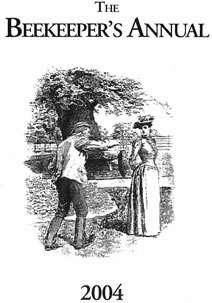 |
THE BEE PRESS
BEECRAFT
Beecraft December 2003 Volume 85 Number 12
The latest issue of Bee Craft offers a wealth of information, advice
and items of interest for all beekeepers in its monthly columns. http://www.bee-craft.com/ The
following is its contents list:
Editorial; Faberge for real Gillian Rose; A beekeeper's Christmas
present Ann W. Harman; Getting started: a time for reflection Margaret
Thomas
NDB; Much the same, but some more red tape Mike Rowbottom; Building
blocks Celia Davis NDB; The 'How to' of hive stand construction Alan
Johnston; Gormanston 2003 Andrew Gibb and Tim Kidman; It's an ill
wind .... Denis Anslow;
The
case of the golden queen's diamonds (1) Karl Showler; Midlands and South
Western Counties Convention - Swansea 2003 Karl Showler.
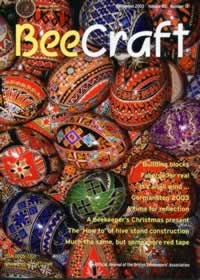 |
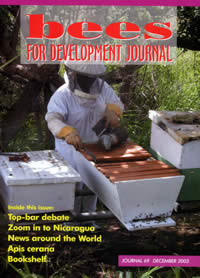 |
BEES FOR DEVELOPMENT JOURNAL
One years subscription (four issues) UK£20 or download only
subscription UK£18 which includes back issues. September
2003 No.69 issue has the following contents: Inside information;
Zoom in to Nicaragua; Practical beekeeping; Letters; News around
the World; Look and Learn Ahead; Notice Board; Project news from
ICIMOD; Book Shelf. Cover picture © Bees for Development.
Our cover picture shows Wellete Toby McMillan, Apiaries Officer
for
Tobago, working in her
apiary of top-bar and frame hives in Tobago. Wellete is a member
of Tobago Apicultural Society working on the project to compare top-bar
and frame hives in Tobago. The Project has been planned by Gladstone
Solomon, President of Tobago Apicultural Society and Bees for Development
and has been supported by the Cariforum Agribusiness Research and
Training Fund. Download previous Bees for Development Journal articles
on top-bar hives and visit our top-bar hive message board. Website
URL: http://www.beesfordevelopment.org and now in Spanish URL: http://www.beesfordevelopment.org/spanish
ARTICLES
AN INVESTIGATION INTO NATURAL COMB (Part 2)
Horizontal and Vertical Comb
Horizontal comb is said to occur when the apex of the hexagon cell
is at the top.
Vertical comb has the apex of the hexagon at the side and is in fact
horizontal comb rotated through 90 degrees.
The shape of the hexagon enables it to withstand
externally applied tensions and pressures in contrasting degree,
dependent upon the
orientation of the apex.
From the diagram below it may be seen that tension applied vertically
and pressure applied horizontally would flatten and elongate horizontal
comb.
However a reversal of these tensions and pressures
would permit the hexagon to more readily retain its shape.
This is due to the horizontal zig-zag component of the hexagon matrix
being restricted regarding stretching and flattening as the vertical
ties prevent the parallel zig-zag components moving apart in an opposite
direction.
A state of equilibrium is obtained and the hexagon shape is maintained.
It is clear therefore that to avoid cell distortion
in natural comb the hexagon cells must be orientated in such a
way as to withstand
the internal tension exerted within the brood nest area.
Ian Rumsey
- To be continued -
In this month’s article, John Yates divides it into two parts:
firstly he makes comment on his local beekeeping magazine suggesting
perhaps that it could do better and secondly, he instructs on the making
and uses of dummy boards; a most interesting topical tip for readers.
If you have any comments on John’s article, or any of the articles
in this news letter, don’t be afraid to let us know. Ed.
Christmas Greetings
The December issue of the beekeeping magazine, which I am forced
to receive as part of my annual subscription, has arrived and contains
its usual amount of tosh and its usual demand for prompt payment
of subscriptions for 2004. I would rather be without the magazine
and consider it an imposition having to purchase it. My annual
subscription is £24 for one full member with no additional BDI. The magazine
contains generally 5-A4 pages in A5 format and I receive 10 publications
per year (total of 50-A4 pages). I belong, also, to a national sailing
association which has a newsletter, containing 24-A4 pages, which
is published 4 times a year (total of 96-A4 pages) – and what
is my annual subscription? £8.00!!! There is talk that it may
be necessary to raise it shortly to £8.50. I know which the
best value is for my money.
Just two small examples of the tosh contained in this month’s
issue:
The first addressed changes to the Honey Regulations whereby the
allowable moisture content has recently altered; fine, but it then
goes on to recommend that the contents of every packaged jar of
honey should be measured with a refractometer before sale. We have
a refractometer
and in the last 20 years it has only been used when judging at
honey shows. About the same time ago these instruments cost over £100
each. I haven’t bothered to check the present price. Modern
parlance to the Editor would be, “Get real”.
The second is a fairly lengthy article, or boring list of beekeeping
equipment, on what to buy the beekeeper for Christmas. There are
no tips for Father Christmas on how to get a WBC hive down the chimney!
There are a lot of beekeepers out there who have not yet tried using
a dummy board. Here is the appendix from our recently updated Study
Notes for the Practical Examination 2nd Edition. This is my offering
for Christmas; make two or three this winter to try next spring,
they are so simple that a blind ‘DIYer’ could make
one.
The dummy board
There are very few books that mention the dummy board which should
be an integral part of every brood box. The British Standard National
hive is examined below; the same bit of arithmetic can be done for
any other type of hive.
The overall width = 181/8". The sides are made of timber ¾" thick,
so subtract 2 x ¾" to get the inside dimension. This
turns out to be 165/8". How many frames will it hold? This of
course depends on the frame spacing, 1½" with metal or
plastic ends and 13/8" with Hoffman spacing. 11 x 1½" =
16½" and 12 x 13/8" = 16½". So the brood
chamber will hold 11 frames with metal or plastic ends or 12 Hoffman
frames. If these numbers of frames are used it is very difficult,
when the colony is up to full strength, to remove the first frame
without 'rolling' and damaging some of the bees. They don't like
this sort of treatment and they get a little short tempered. It is
good beekeeping practice to use 10 x 1½" = 15" or
11 x 13/8" = 151/8" which leaves a gap of 15/8" and
1½" respectively. This gap is for the dummy board (about ½" thick)
and when it is removed the gap provides the space needed to manipulate
the colony.
What a nice simple and useful system it is and it costs virtually
nothing. A dummy board is piece of wood having exactly the same profile
as the frames being used in the brood chamber. The thickness is immaterial
and a dummy board can be made from any suitable scrap material that
happens to be around. Note that there is a bee space all round its'
edges and it should not be confused with a division board which divides
the brood chamber into two bee-tight compartments and is an entirely
different piece of equipment with a very different use.
Consider some of the advantages of the dummy board:
a) During a manipulation all the frames remain in the hive except
the one being examined. No frame leaning against the outside of the
brood chamber to be kicked over and all the bees are in the hive
where they can be controlled.
b) The frames can be levered up tightly with the hive tool between
the outer surface of the dummy and the inner wall of the hive. This
keeps frame spacing correct and stops a build up of propolis at the
spacers.
c) The dummy board is replaced at the opposite end of the brood chamber
when the manipulation is complete. There is no need to move all the
frames back into the original positions.
d) The brood chamber can be varied in size as required. For example,
reducing it to force honey into the supers or to enlarge it when
a nuc is being expanded into a full size colony by adding frames
from time to time.
Not only should every brood chamber have its own dummy board but
every nuc box should have one too. If you're sceptical about them,
make one and give it a try for a complete season and then make
up your own mind. JDY. December 2003
Mathew Allen Continues with his ramblings,
and this year ranges through the Antipodes, Tomatoes, sexless
plants and poetry. All the ramblings of course
having a point to them.
‘So Who’s The Convict Now, Cobber?’
‘Ooooh, what a lovely present, a jar of your own honey. Thank
you so much for bringing it all this way.’ My friend Peter
visualised the smile on his auntie’s face as he arrived at
her house in Australia, but it was not to be. He was frog-marched,
like the criminal he nearly was, to a security grilling at Customs
at Sydney Airport. Forget about taking honey with you to the Antipodes,
or royal jelly, or pollen, or wax and definitely not live bees or
honeycomb. It’s regarded as a very serious matter. Peter got
off with a dressing-down, which he resented. He swallowed his pride,
but not his prize-winning Buckinghamshire honey – that was
confiscated and destroyed.
Why such a draconian response? The convicts’ descendants getting
their own back? Well, both New Zealand and Australia take their agriculture
very seriously, and are well aware that the value of pollination
greatly exceeds the value of all other hive products combined. The
point of import bans is to reduce the risk of diseases and parasites
getting in. Imagine a serious pest taking its toll on New Zealand’s
bees. We wouldn’t see much in the way of their apples, kiwi
fruit, dairy products, mutton and so forth (to say nothing of the
four tonnes of cranberries we import annually).
Here you are arriving by air in New Zealand. You
have to sign a declaration on the plane disclosing any bee products.
Last year 4050
people admitted having bee stuff with them, mostly honey. An astonishing
1634 denied having bee products, and were then found to have something.
Some could be excused – who remembers things like cough medicine
or beauty products? Others just tried smuggling the odd jar of honey
through and got caught. The statistics make interesting reading.
Unfortunately they don’t give any clues as to the punishments
meted out.
Nearer to home. This year, I spent a happy couple
of days at the Chelsea Flower Show (work, not leisure), and was
heartened by the
initiative from National Trust and English Nature to persuade gardeners
to grow more bee-friendly flowers. For hundreds of years plant breeders
have been selecting plants with more and more elaborate flowers.
In many of these the sexual parts, ie the stamens and stigmas, have
been transformed back into petals, making a more showy flower, but
one incapable of providing food for bees. So go for simple flowers
is the message, and we’ll get more bees around.
It’s a massive media event of course, with
a tv star round every corner. Rachel de Thame, the latest Gardening
Goddess, came
to talk about some bee input to her next series. If that comes off
it will be fun...
I have been doing some work with bees in glasshouses,
pollinating tomatoes. I thought there could be an opening here,
because we eat
a lot of tomatoes. Just how many tomatoes, I hadn’t realised.
I now have the figures for 2001. World production 100 million tonnes;
European production 20 million tonnes; Spanish production almost
4 million tonnes; UK production just over 100,000 tonnes. And they
all need bees!
Let me finish with another bit of poetry, this time from the Bhagavad
Gita-
This epic Mahabharata
Is a bright blue water lily.
Her Gita is the precious pollen;
Sipping as a humble bumble bee, relish her sweet nectar
And bathe yourself in the
Honey of wisdom.
Honey of wisdom – I like that.
Matt Allen
A PERSONAL VIEW ON THE 2003 NATIONAL HONEY
SHOW
The 2003 National Honey Show took place at Kensington Town
Hall, Kensington, Horton Street where it has been an established
event for some years.
I look forward to the National as an opportunity to catch
up with old friends and make some new ones. I also like
the company of beekeepers and meeting the public to share
our fascinating hobby.
I was at the opening ceremony which was held at the bottom
of a stairway by the lifts which is not a good backdrop
for the audience of several hundred beekeepers and press
cameras, Kim Flottum the editor of Bee Culture was the
honoured guest and officially opened the show.
This year, for the first time, I was a judge’s steward.
This involved helping the judge keep his equipment clean
and assisting in the process of judging. I was impressed
by the thorough scrutiny that the judges give the exhibits.
It was also helpful to me, as a competitor, to watch
as the judges cast their experienced eye over the exhibits.
I had not realised how some classes are very difficult
to judge because of the diversity of the entries within
the class.
The honey displays looked good because of the hundreds
of lights in the ceiling reflecting on all the glass. The
overall effect of the lighting and exhibits was truly stunning.
I walked around the displays for hours looking at all the
hundreds of classes, some folk had travelled along way
to exhibit, Virginia Webb from the USA had some initiative
ideas for wax and displays and was awarded a number of
1st prizes.
I have entered honey classes at the National for a number
of years, each time with limited success. This year I was
delighted to win two first prizes (classes 1a and 167)
with my light honey. The winning of a first prize at the
National represented the fulfilment of a personal goal
and the feeling was very gratifying.
This year I attended three lectures, I particularly enjoyed
Willie Robson’s lecture on honey marketing. He made
a somewhat dry subject very entertaining. I thought Kim
Flottum’s talk on the small hive beetle was very
informative.
Next year, the National Honey Show will be moving to the
RAF Museum at Hendon, North London, it will also take place
in October (21st-23rd) instead of November. The new venue
has free parking and is easily accessed from the M1 and
M25. I look forward to seeing you all there. Steven
Turner
Below are some of the photographs taken during the 3 days at the Honey
Show.
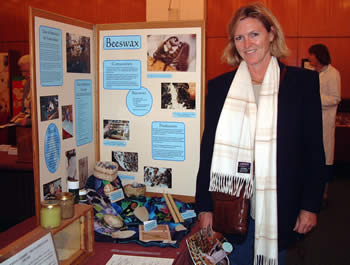 |
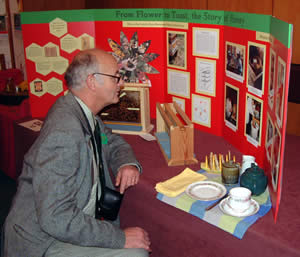 |
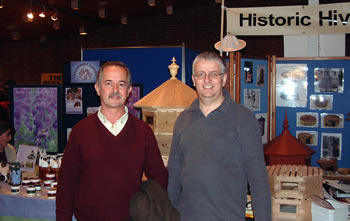 |
David Cramp & Steven Turner |
 |
Visitors from Ireland |
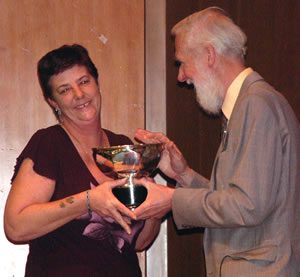 |
Presentation
of the trophies on the last day of the show |
 |
 |
Visiting London Beekeepers |
THE SEARCH FOR ANSWERS
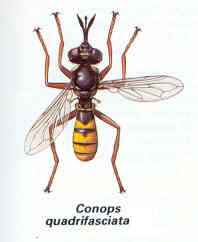 |
At last we have got somewhere in the search for a solution to the
hollow bumblebee business. Several months ago a reader wrote to Apis-UK
with a query. He had found some bumblebee husks, hollow etc and asked
how this could come about. Just recently, an acquaintance told me
that he thought some fly or other ate their insides. With this line
of thought I consulted more experts and discovered that one of the
predators of the bumblebee (and other hymenoptera) is the conopid
fly. This group of broadheaded flies, the conopidae have many members
some of which mimic wasps, but one which uses the bumblebee is the
Conops quadrifasciata. This fly which as you can see has wasp similarities
waits near flowers used by bumblebees. When its prey arrives, it
swiftly pierces the bee's body and lays an egg inside it. The egg
hatches and the larva feed off the abdominal contents of the bumblebee
for about 10 days effectively hollowing it out and filling almost
the entire abdominal cavity. The larva pupates in side the bee becoming
an adult fly the next summer. The fly then of course vacates the
husk of the bumblebee, which remains as it is, i.e. a hollow bumblebee.
The parasite appears to change the behaviour of the bee which tends
to stay outside of the nest more than other workers often remaining
outside even in very cold weather. Before it dies the bumblebee,
attempts to bury itself under earth as though wanting to hibernate.
The result is a hollow bumblebee (or several) lying around waiting
to be discovered by some inquisitive person.
POEM OF THE MONTH
|
A haiku.
In the shade of a leaf
a column of ants carries
a dead bee.
Natasa Stankovic. Serbia
|
FACT FILE
A BRIEF RESUME OF RESEARCH INTO VARROA
This month’s fact file was to be a summary of our knowledge
of Drone Congregation Areas, but this will now be a subject
for a future fact file - probably in the February issue.
Instead, we offer a resume of who is doing what on the varroa
front. This is not intended to be an exhaustive survey of
varroa research but simply information on some of the more
interesting points. This fact file also illustrates the importance
of science to the beekeeper in the street.
Most beekeepers now manage to keep varroa under control,
and most are aware of the new products such as Apiguard (Vita
Europe Ltd) and Apilife Var (Chemicals LAIF) which are thymol
based preparations together with other natural substances
in the latter case. These products, the result of much research
on the part of the companies involved are a welcome advance
in the fight against varroa but we all know that we aren’t
in the end game phase of the fight and that in order to win,
we need to develop cheaper thymol preparations, as well as
effective new weapons; natural predators; semiochemicals
and ultimately the varroa tolerant bee.
REDUCING THE PRICE OF THYMOL
Whilst other substances such as various acids, dusts and
flours and oils of different types have been used against
varroa, many scientists have found that thymol is one of
the more useful substances and have concentrated on this
for purposes of research and development in the varroa
fight. But a thymol preparation comes with a price tag
and because of this many beekeepers all over Europe refuse
to pay this and use their own concoctions. A case in point
is Spain where many beekeepers use varying amounts of pure
thymol crystals, cheap sheep dip preparations based on
fluvalinate, or worse. Spanish scientists at Cordoba University’s
Andalucian Centre for Ecological Apiculture (CAAPE) have
therefore spent several years researching thymol with the
idea of producing a cheap and effective preparation that
the beekeepers will actually use. Firstly they found that
pure thymol (99%) that came into contact with bees could
cause retardation of the development of the colony and
in some cases caused a decline in the colony. Careful dosage
was therefore essential. Having found an effective dose
they then devised a way of treating the colony effectively.
They finally came up with the following, and extensive
and wide ranging field trials in the various different
climates of Spain are now underway. They advise the following:
8 grams of thymol (99%) pure is added to 12 grams of olive
oil. (This is cheap in Spain, but I’m sure that any
food grade vegetable oil would do). This should be warmed
and stirred until the crystals are fully dissolved. Then
obtain one of those green florist sponges and make a piece
9 X 5 X 0.8cm and soak it in the oil until it is full. Break
the sponge into two pieces and place the pieces over the
brood frames, equally spaced. Leave for 2 weeks and repeat.
This should be done in the Spring and can be repeated in
the Autumn, although they stress that thymol is only one
tool in the fight and that alternate treatments of other
varroacides are advised. To this end they are now beginning
research on a cheap, easy and effective way of delivering
oxalic acid to hives.
THE USE OF NATURAL PATHOGENS
In the UK, Rothamsted Research which is the oldest laboratory
in the world devoted to agricultural research, has engaged
in active bee research since 1932. Their research recently
has focussed on varroa and the losses caused by bee virus
infections that the mite transmits. In the first phase of
a collaborative project with Horticulture Research International,
they are investigating potential biological control agents
for V destructor. This phase which is now complete has identified
and characterised fungal pathogens which are active against
the mite but which are relatively safe for bees and other
beneficial insects. There have been some encouraging results
in this field of study, suggesting that biological control
offers an environmentally acceptable approach to the problem,
and could have considerable economic benefit. Research is
continuing.
THE USE OF SEMIOCHEMICALS
The use of semiochemicals to control varroa has had a less
promising start. (Semiochemicals are all compounds produced
in glands that secrete to the exterior. Secretions of these
exocrine glands include pheromones). Italian research has
shown that these semiochemicals appear to be involved in
nearly all stages of the life cycle of varroa, but from a
practical point of view, they may have a greater or lesser
importance, depending on which part of the mite’s anatomy
they can interfere with. Models of varroa population dynamics
can help to pinpoint the crucial of the mite’s life
cycle and so enable investigations to be focussed on the
semiochemicals that are more likely to guarantee results.
This thorough and necessary Italian research has not resulted
yet in much success. One product resulting from this research
called Varoutest was used to treat parts of brood combs in
order to trap the mites there, but field trials were not
a success. The whole subject is immensely complicated. The
varroa mite is of course well adapted to the complex biology
of its host, and so many factors and variables may be present
which are not yet fully understood.
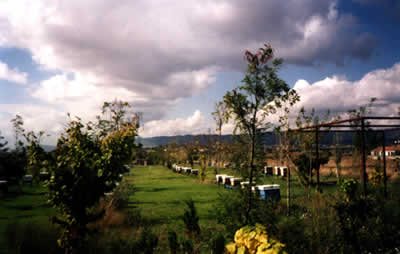 |
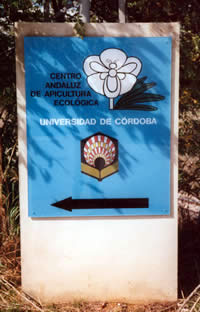 |
| Photographs:
The
sign for the bee unit (CAAPE) at Cordoba University
and the research apiary at Cordoba. |
VARROA TOLERANT BEES
Varroa tolerant bees are the ultimate in varroa control and
the dream of all beekeepers. Many scientists in many countries
are engaged in research to produce such a bee and Spanish
scientists at Cordoba are confident of a certain measure
of success. They have now reached the stage where they are
not treating their bees in the research apiary, but fully
recognise that environmental factors may play a large part
in the equation. Will these bees be varroa tolerant in other
areas? This remains to be seen but Dr Francisco Puerta who
heads the research unit tells me that just as with the thymol
preparation, extensive field trials are planned throughout
Spain.
John Harbo, a scientist at the well known USDA bee lab at
Baton Rouge is engaged in a lengthy piece of research aimed
at using suppression of mite reproduction in order to reduce
mite reproduction to an unsustainable level. His team have
now reached this stage and are able to produce queens with
this trait. Currently however the trade off appears to be
a smaller brood frame and John has told me that work is now
in progress to change this effect. A full report on this
will appear in a future issue of Apis-UK.
So, in this short summary of interesting research into the
problem of varroa, we can see that many investigations are
in progress and the ultimate winner in all this will be the
beekeeper. It is not just a case of boffins engaging in esoteric
works. Their complex research today means solutions for beekeepers
tomorrow.
Web sites
Rothamsted Research. http://www.iacr.bbsrc.ac.uk
CSL National Bee Unit. http://www.nationalbeeunit.co.uk
Vita Europe Ltd. http://www.vita-europe.com
ChemicalsLAIF. http://www.chemicalslaif.it
CAAPE (Cordoba University. Email: BA1PUPUF@uco.es
A HONEY RECIPE
This new section aims to provide a recipe each month which uses honey
as an essential ingredient but which is fairly unusual. Help would
be appreciated! We’ll see how it goes. Overseas recipes are
welcome.
RECIPE
This recipe from the IBRA Newsletter Buzz Extra (See in the News), is a new recipe
from Jane Jones, the author of the book Traditional Welsh Honey Recipes published
by Bee Books new and Old (BBNO) and is one of those cakes that you don't need
to cook. In fact it 'cooks' in the fridge. The ingredients are as follows:
5oz/150g of chopped dried apricots.
5oz chopped, ready to eat prunes.
3 large balls of stem ginger, chopped and drained.
3oz/75g of good quality honey.
4 fluid oz/125ml of Brandy.
1 tbsp* of the syrup from the ginger jar.
120z/350g of plain chocolate broken into pieces.
5oz Unsalted butter.
6oz/175g Digestive biscuits, crushed.
Lightly oil a 7X7" 18X18cm baking tin
and line with cling film.
Leave enough hanging over the rim to wrap up the cake entirely.
Put the apricots, prunes, stem ginger and syrup, honey and
brandy into a pan. Heat gently, do not boil. Leave for 30
minutes for the fruit to soak into the syrup.
Meanwhile, put the chocolate and butter into a large bowl
over a pan of hot water, stirring together until melted.
Add the crushed biscuits and fruit to the bowl and mix all
the ingredients together. Spoon the cake mixture into the
prepared tin, levelling the surface. Seal up in the cling
film and chill for at least 6 hours or overnight in the fridge.
This makes about 12 to 14
slices.
*(For overseas readers, a tbsp (tablespoon) is a large spoon
which holds I would guess about 5 or 6 teaspoon fulls).
I've now tried this and it is delicious.
Trying to put double the brandy in 'to make sure of things'
by the way, doesn't
work. It tastes good but you need a spoon. Ed.
Jane Jone's
book is available now from the IBRA bookshop and BBNO.
HISTORICAL
NOTE
APITHERAPY. CURING PAIN AND CONSTIPATION
In his Treatise on Bees written in 1792, Robert Sydserff
includes a chapter on the profitability of keeping bees
and gives advice on how to attain this profitability, but
at the end of his chapter, he concludes that bees have
other ways of paying back the beekeeper than just honey
production and suggests the following cures which may apply
to us all with the Christmas excesses. Something for hangovers
and tummy problems.
‘
The use of bees is still greater. By what has been observed
above, it is plain that we gain only food and raiment,
and yet these are considerable advantages. But we may ask, “Is
not the life more than meat, and the body than raiment?
They are salutary and efficacious also as a medicine. How
many lives have, to appearance, been prolonged by the Bees?
If Bees, when dead, are dried to powder, and given to either
man or beast, this medicine will often give immediate ease
in the most excruciating pain, and remove a stoppage in
the body, when all other means have failed.” R Sydserff.
Leigh on Mendip. 1792. If anyone tries this,
please let us know the results. Ed.
LETTERS
Dear David,
Could I enquire via your newsletter if anyone knows
where I can get propolis which has collected from hive wood
ware purified?
As you know some propolis obtained in this way is in clean
lumps, presumably as "pure" as the bees make it,
whilst some scraped from surfaces is "dusty" and
presumably not so pure. Any information would be gratefully
received on how pure it needs to be for various applications,
, how "purity" is measured, whether anyone offers
a purification service or if there are ways of doing it oneself.
Thank you, Steve Mahoney steve@mahoney.evesham.net. If anyone has any information on this, please let us know. Ed.
Dear David,
Thanks for Bunin's poem in the latest on line magazine.
Was it your own translation from the Russian? If so, I was
impressed! What text did you work from? Best regards John
Owen jeowen@fish.co.uk. Thanks for the note. Unfortunately,
although I can translate from Russian, it doesn't extend to
poetry. I can't
even do
that in English! I'll ask Predrag which work he used for this
and let you know. Ed.
Dear David,
Disappointed that we have had no suggestions
re the
hollow bumble bee question. Brian Hughes bdh@berrywood.fsnet.co.uk.
Brian, we
may have finally found an answer to your query. See
above about the Conopid fly. Ed.
BEEKEEPING
COURSES
Two courses to be run by Northamptonshire
Beekeepers' Association
Beginners Course 2004
Getting started in beekeeping. Ten weeks of lectures
with two practical sessions handling bees.
VENUE: Abbey Centre, Hunsbury Hill, Northampton
DATE: Start 24 January 2004 TIME: Saturday mornings 9.30 am
- 11.30 am
FEE: £30.00 per person BOOKING & ENQUIRY: Margaret
Holland Tel: 01327 857328 E-mail secretary@northantsbees.org.uk.
One Day Refresher Course 2004
Revision of the basics of beekeeping for those new to beekeeping
with an opportunity to take the BBKA Basic Exam (optional).
COURSE LEADER Adrian
Waring NDB & Brian Dennis
VENUE: Knuston Hall, Knuston, Nr Irchester, Wellingborough
TIME: 9.30 am - 4.30 pm DATE: 26 June 2004
FEE: £26.00 per person, to include coffee, lunch, afternoon tea. BOOKING & ENQUIRY:
Margaret Holland Tel: 01327 857328 E-mail: secretary@northantsbees.org.uk.
Introduction beekeeping course
run by the London Beekeepers Association at
Roots and Shoots on Wednesday evenings for
ten weeks starting Wednesday 14th January
2004 Details from the website www.kentbee.com
A Beekeeping Course is being run by Community
Education Lewisham at Mornington Centre from
20th April until 18th May 2004. The classes are on Tuesdays
at 10.00 until 12.00 for five weeks. The tutor is Karl-Josef
Kemper. Details from 020-8698-5819
DATES FOR YOUR
DIARY
Event organisers are welcome
to forward dates and details of their events to the editor
(by e-mail) for incorporation on this page.
22-25 February 2004 - Apimondia
Symposium on Tropical Beekeeping: Research and Development
for Pollination and Conservation. Heredia Costa Rica
More detail is available from: Isanchez@una.ac.cr
23-27 February 2004 - 7th Asian
Apicultural Association Conference Los Banos College,
Lagunas, Philippines. More information from: cleofas.cervancia@up.edu.ph
Saturday March 6th 2004 10.0am to
4.0pm - Bucks County Beekeepers Association Annual Seminar, Wendover
Memorial Hall, Wharf Road, Bucks..
10.00 Meet for coffee and registration
10.30 Welcome
10.40 Integrated pest management Richard Ball, Regional bees
Inspector for the South West
11.40 Short Break
11.50 Beekeeping in the future John Hamer of Blackhorse Apiary.
1.00 Ploughman’s lunch with time to chat and get your
bargains from the ‘Bring and Buy’ stall, find out
about Transrural Trust read the posters and more..........
2.15. “Have skep, will travel” Martin Buckle Chairman of Bucks
County BKA.
3.15 Forum A time for questions and discussion with our experts
4.00. Closing remarks
We extend a welcome to all beekeepers and others interested
in beekeeping
Cost:- £10 for BBKA members, £11 for non-members
Ploughman’s
lunch and coffee etc. included To book:- please telephone Sylvia
Chamberlin on 01494522082 or Email sylvia.chamberlin@zen.co.uk.
Saturday 3rd April 2004 - West Sussex
Beekeepers' 'Joy of Beekeeping' Convention - a Celebration
of Bees, Beekeeping and Hive Products
at Brinsbury College, on A29 north of Pulborough. Speakers
include Dr Beulah Cullen, Clive de Bruyn and Margaret Johnson.
Trade Stands. Lunch available in the College Restaurant. From
9.30am until 4pm, a superb day of beekeeping, with tickets £6
in advance (£8 on the day) from Andrew Shelley, Oakfield,
Cox Green, Ridgwick, Horsham RH12 3DD (sae appreciated). Further
information from John Hunt on 01903 815655 or email john_bateman_hunt@hotmail.com. 24th April 2004 BBKA Spring Convention
and Exhibition
16th April 2005 BBKA Spring Convention and Exhibition
Harrogate and Ripon
BKA Events Listing 2004
(All meetings unless otherwise notified are held in the
Field Classroom at Harlow carr at 7.30pm.
13 Jan. Beekeeping Health
and safety Issues.
19 Feb. Maintenance of Heather Moors.
March Date TBD. Beekeeping medicines.
23 Apr. Observation Colonies.
23 May. Visit to Chainbridge Honey
Farm.
6-10 September 2004 - 8th IBRA Conference on
tropical Bees: management and diversity. Ribeiro Preto, Brazil.
21st, 22nd and 23rd October 2004 - The
National Honey Show, RAF
Museum, Hendon, North London. More details soon from http://www.honeyshow.co.uk
HOLIDAYS 2004
June 2004 - Holiday to Denmark. Following
an invitation from Danish Beekeepers, the BBKA is planning a visit
to Denmark for British beekeepers to experience the way
Danish beekeepers keep bees, how they breed them for gentleness,
high honey production, reduced swarming, and good hygiene. We will
also see much innovative modern beekeeping equipment and learn
of the Danish beekeepers approach to honeybee disease and its treatment.
The use of Apistan or Bayvarol is not permitted in Denmark. Each
day there will also be parallel activities arranged for any who
want to shop, or experience some of the local history, flora, and
wild life reserves. For example, there is a nearby museum with
salvaged artefacts from the stranding in 1811 of Nelson’s
flag ship HMS St George at the Battle of Copenhagen, and from the
Battle of, Jutland on 31st May 1916. The BBKA visit follows a successful
tour by the Bee Farmers earlier this year and will cover a similar
schedule of intensive lectures and visits to professional beekeepers.
Beekeeper partners are welcome. You will need to take local currency
(DKr.) Half-board hotel accommodation has been tentatively booked
at the Best Western 4-star Hotel Fjordgaarden in Ringkøbing
from Thursday 24th June to Monday 28th June 2004. The cost will
depend to some extent on numbers but the following provisional
breakdown gives an approximate idea per person. To indicate your
interest, PLEASE ring Raymond or Sylvia Chamberlin on 01494 522082,
or email w.winds@zen.co.uk.
Editor: David Cramp Submissions
contact the Editor
Web Editor: Steven Turner
E-mail addresses are not hyper linked to prevent harvesting
for spamming purposes. We recommend you cut & paste
to your e-mail client if required.
Click
here to print this page |